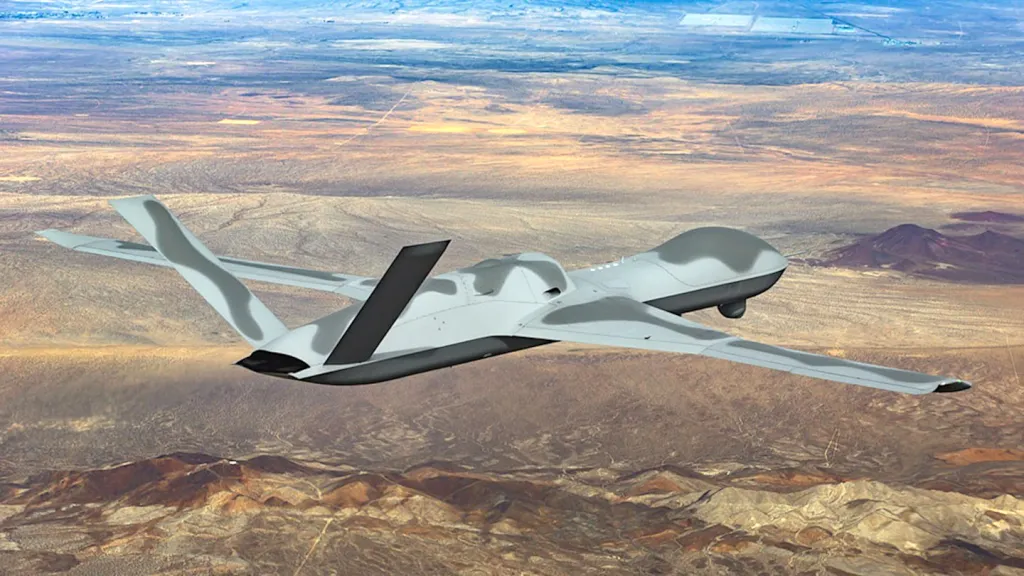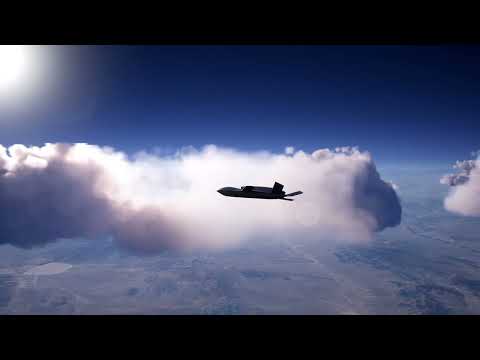F-22 Pilot Controls MQ-20 Drone From The Cockpit In Mock Combat Mission
An MQ-20 Avenger drone flew a mock mission at the direction of a pilot in an F-22 Raptor during a demonstration earlier this year, General Atomics has disclosed. The company says this is part of a larger effort to lay the groundwork for crewed-uncrewed teaming between F-22s and Collaborative Combat Aircraft (CCA) drones. General Atomics and Anduril are currently developing CCA designs for the U.S. Air Force, and that service expects the Raptor to be the first airborne controller for whichever types it decides to buy in the future.
General Atomics made its announcement about the MQ-20/F-22 teaming demonstration today, around the opening of the biennial Dubai Airshow, at which TWZ is in attendance. The actual event, which the company internally funded, took place back in October in the skies over the U.S. Air Force’s sprawling Nevada Test and Training Range (NTTR). Lockheed Martin, the prime contractor for the F-22, and L3Harris also took part.

“We recently teamed Avenger with a badass fighter jet for a true airborne, crewed-uncrewed internal demo, where the human pilot commanded the autonomous Avenger from the cockpit for a hypothetical mission,” C. Mark Brinkley, a spokesperson for General Atomics, told TWZ. The “MQ-20 Avenger continues to serve as an autonomy accelerator, routinely flying in a CCA configuration, pushing the envelope.”
“The [crewed-uncrewed teaming demonstration] effort integrated L3Harris’ BANSHEE Advanced Tactical Datalinks with its Pantera software-defined radios (SDRs) via Lockheed Martin’s open radio architectures, all integrated and shared from an F-22 Raptor,” according to a General Atomics press release. “Two L3Harris Software‑Defined Radios (SDRs) supported the demonstration. The first SDR was installed into the General Atomics MQ‑20 Avenger, and the second was integrated in the Lockheed Martin F‑22 Raptor.”

“Through the Pilot Vehicle Interface (PVI) tablet and the F‑22’s GRACE module, the system provided end‑to‑end communications, enabling the F‑22 command and control of the MQ‑20 in flight,” the release adds. “The collaborative demonstration showcased non-proprietary, U.S. government-owned communications capabilities and the ability to fly, transition, and re-fly flight hardware that is core to the Open Mission Systems and skills based unmanned autonomy ecosystem.”
The “GRACE” mentioned here refers to the Government Reference Architecture Compute Environment. This is a previously announced open-architecture systems module for the F-22 that is designed to make it easier to integrate new software packages onto the aircraft, including ones to support the airborne drone controller role.
The explicit mention of a tablet-based in-cockpit control interface is also worth highlighting. General Atomics and Lockheed Martin have both been working for years now on control systems to allow crewed aircraft to direct drones in flight, with tablet-like devices being the typical user interface. However, both companies have themselves raised questions to varying degrees about the long-term viability of that arrangement, especially for pilots in single-seat fighters, who already have substantial workloads during real-world missions.
“We started with [the Air Force’s] Air Combat Command with tablets … There was this idea that they wanted to have this discreet control,” Michael Atwood, vice president of Advanced Programs for General Atomics, said during an appearance on The Merge podcast last year. “I got to fly in one of these jets with a tablet. And it was really hard to fly the airplane, let alone the weapon system of my primary airplane, and spatially and temporally think about this other thing.”

“There’s a lot of opinions amongst the Air Force about the right way to go [about controlling drones from other aircraft],” John Clark, then-head of Lockheed Martin’s famed Skunk Works advanced projects division, had also told TWZ and others at Air & Space Forces Association’s (AFA) main annual conference in September 2024. “The universal thought, though, is that this [a tablet or other touch-based interface] may be the fastest way to begin experimentation. It may not be the end state.”

These are the kind of questions that demonstrations like the one General Atomics conducted in October over the NTTR could help answer. As TWZ regularly notes, there is still much to be worked out when it comes to how future CCA fleets are structured, as well as how they are deployed, launched, recovered, supported, and otherwise operated, let alone employed tactically.
“General Atomics is in a pretty unique situation here, given that we already have operational uncrewed jets to use for experimentation,” Brinkley, the General Atomics spokesperson, told TWZ. “The MQ-20 Avenger, tricked out with mature mission autonomy software, is a perfect CCA surrogate and allows us to move fast and move first.”
It’s important to stress here that Avenger drones have been heavily utilized as testbeds for advanced autonomy and other developments related to CCA-type uncrewed aircraft for years now. The jet-powered drones have some low observable (stealthy) features, as well as an internal payload bay. Much of this work has been in cooperation with the U.S. Navy, as well as the U.S. Air Force. How much crewed-uncrewed teaming testing involving the F-22 and the MQ-20, or other surrogates, may have already been done in the classified realm is unknown.

“We’re leaning forward, because we already know where this is headed,” Brinkley added. “We don’t want to wait for the CCA fleet to be fielded to begin leaning in on F-22 teaming. We already know the F-22 will play a critical role in crewed-uncrewed teaming operations, and General Atomics is in a unique position to get started now.”
As mentioned, the F-22 is slated to be the U.S. Air Force’s first airborne CCA controller, something the service revealed this past summer in its 2026 Fiscal Year budget request. This was further confirmed in an unclassified Air Force report to Congress in October, which otherwise outlined a highly aspirational 10-year plan for the service’s fighter fleets that puts significant emphasis on CCAs.
“F-22 remains the threshold platform for CCA but integration with F-16, F-35A, F-15E, and F-15EX is an emerging consideration,” according to that report. “Ultimately, CCA will be paired with [the sixth-generation] F-47 to meet highly contested mission demands.”

“America’s adversaries are countering US air power with greater mass and a challenging air defense laydown that limits the United States’ ability to project combat power in traditional ways,” the report adds. “CCAs allow for risk-tolerant aircraft at a lower price point and serve as a force multiplier.”

The fighter force structure report also says that details about exactly how many CCAs the Air Force currently plans to buy and across what timeline are currently classified. Air Force officials have said in the past that between 100 and 150 drones will be ordered under the CCA program’s first phase, or Increment 1, with hundreds more expected through future incremental development cycles. Whether the service plans to down-select to a single type or buy multiple designs for the first tranche remains unclear. As mentioned, General Atomics and Anduril are currently developing drones for Increment 1, which are now designated the YFQ-42A and YFQ-44A, respectively. General Atomics announced that the YFQ-42A had made its first flight in August. The YFQ-44A took to the skies for the first time last month. The goal is for operational Increment 1 CCAs to begin entering service around the end of the decade.


CCA drone developments are not limited to the U.S. Air Force, either. The U.S. Marine Corps and U.S. Navy have their own CCA efforts ongoing. All three services are directly collaborating on common control architectures and other elements. General Atomics is also one of several companies now developing conceptual CCA designs for the Navy. The company is now actively pursuing foreign sales of drones in this general category, leveraging its Gambit family of highly modular designs, as well. Other companies in the United States and elsewhere globally are eyeing steadily growing opportunities in this market space, too.
“There are companies all over the world making big promises while they figure all of this out for the first time. How to build an airplane, how to incorporate autonomy, how to team that with manned aircraft,” General Atomics spokesperson Brinkley told us. “We’ve been putting our own money into uncrewed jets for 17 years. This [the MQ-20/F-22 demonstration] is just one more milestone in a long history of leaning forward. We’re not out here saying ‘I think I can, I think I can.’ We know we can.”
With the F-22 set to be the Air Force’s first airborne CCA controller, work to continue proving out the Raptor’s crewed-uncrewed teaming capabilities will be especially important.
Update, 1:45 PM EST:
Lockheed Martin has now provided its own remarks regarding the MQ-20/F-22 teaming demonstration.
“Lockheed Martin Skunk Works led and orchestrated this crewed-uncrewed teaming flight test with GA-ASI [General Atomics Aeronautical Systems, Inc.] and L3Harris. This demonstration involved an F-22 Raptor, an MQ-20, and Skunk Works’ flexible and hardware-agnostic pilot vehicle interface to showcase capabilities critical to the U.S. Air Force’s Collaborative Combat Aircraft family of systems,” the company told TWZ. “Lockheed Martin’s phased approach to building, testing, and improving teaming capabilities is at the forefront of innovation, developing the future of air combat today.”
“This effort represents Skunk Works bringing its diverse and unique expertise to the table to lead the way, demonstrating the future of air combat, where single-seat aircraft command and control drones with simple and intuitive interfaces in the cockpit,” O.J. Sanchez, Lockheed Martin Vice President and General Manager of Skunk Works, also said in a statement to TWZ.
Contact the author: [email protected]






